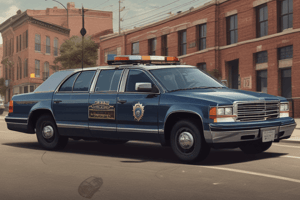Podcast
Questions and Answers
What is a common reason for transporting persons in custody?
What is a common reason for transporting persons in custody?
- Vacation trips
- Transfer for educational purposes
- Meeting family members
- Immediate booking after arrest (correct)
Transportation of prisoners only occurs when they are being taken to court.
Transportation of prisoners only occurs when they are being taken to court.
False (B)
What is a potential risk associated with transporting prisoners?
What is a potential risk associated with transporting prisoners?
Danger to officers and the public
Transportation usually occurs immediately after arrest and for reasons such as taking prisoners to a _____ or hospital.
Transportation usually occurs immediately after arrest and for reasons such as taking prisoners to a _____ or hospital.
Match the following types of transportation with their descriptions:
Match the following types of transportation with their descriptions:
What should officers do before placing a prisoner in the vehicle?
What should officers do before placing a prisoner in the vehicle?
Juvenile prisoners may be transported with adult prisoners if they know each other.
Juvenile prisoners may be transported with adult prisoners if they know each other.
What type of equipment should officers use while searching prisoners?
What type of equipment should officers use while searching prisoners?
Items removed from a prisoner prior to transport will be securely maintained and returned to the prisoner or turned in to the booking officer upon arrival at the location of _____.
Items removed from a prisoner prior to transport will be securely maintained and returned to the prisoner or turned in to the booking officer upon arrival at the location of _____.
Match the following actions with their descriptions:
Match the following actions with their descriptions:
What is required from the custodian of the prisoner before transportation?
What is required from the custodian of the prisoner before transportation?
Transporting first occurs during a prisoner's trial.
Transporting first occurs during a prisoner's trial.
When is it necessary to search the police vehicle?
When is it necessary to search the police vehicle?
What is the primary purpose of the metal or plastic screen in transport vehicles?
What is the primary purpose of the metal or plastic screen in transport vehicles?
Prisoners can be transported in a prone position to ensure their safety.
Prisoners can be transported in a prone position to ensure their safety.
What must be done with the rear interior door and window handles in vehicles transporting prisoners?
What must be done with the rear interior door and window handles in vehicles transporting prisoners?
A prisoner shall be positioned in the right front seat and secured with a seat belt when transported by a single officer in a vehicle without a ______.
A prisoner shall be positioned in the right front seat and secured with a seat belt when transported by a single officer in a vehicle without a ______.
Match the following protocols with their respective descriptions:
Match the following protocols with their respective descriptions:
What should an officer do when a prisoner shows signs of lethargy after a confrontation?
What should an officer do when a prisoner shows signs of lethargy after a confrontation?
Transporting officers can engage in high-speed pursuits while transporting a prisoner.
Transporting officers can engage in high-speed pursuits while transporting a prisoner.
What should be done if a prisoner escapes during transport?
What should be done if a prisoner escapes during transport?
When there are multiple prisoners, officers should position themselves behind the ______ to monitor the prisoners.
When there are multiple prisoners, officers should position themselves behind the ______ to monitor the prisoners.
What is an important factor officers should consider before transporting prisoners?
What is an important factor officers should consider before transporting prisoners?
Flashcards
Booking Transport
Booking Transport
The act of moving a person under arrest to a designated location, such as a jail or police station, following their apprehension.
Prisoner Transport
Prisoner Transport
The process of moving a prisoner from a detention facility to another location for medical care, court appearances, or other purposes.
Transporting Prisoners - Risks
Transporting Prisoners - Risks
The potential risks associated with transporting prisoners, including dangers to officers, the public, and the prisoner themselves.
Transporting Prisoners - Precautions
Transporting Prisoners - Precautions
Signup and view all the flashcards
Transporting Prisoners - Policy
Transporting Prisoners - Policy
Signup and view all the flashcards
Initial Prisoner Transport
Initial Prisoner Transport
Signup and view all the flashcards
Subsequent Prisoner Transport
Subsequent Prisoner Transport
Signup and view all the flashcards
Prisoner Transport Risks
Prisoner Transport Risks
Signup and view all the flashcards
Prisoner Transport Policy
Prisoner Transport Policy
Signup and view all the flashcards
Transporting Prisoners in Patrol Vehicles
Transporting Prisoners in Patrol Vehicles
Signup and view all the flashcards
Separate Transport for Juveniles
Separate Transport for Juveniles
Signup and view all the flashcards
Verifying Prisoner Identity
Verifying Prisoner Identity
Signup and view all the flashcards
Searching the Prisoner Before Transport
Searching the Prisoner Before Transport
Signup and view all the flashcards
Barrier in Transport Vehicles
Barrier in Transport Vehicles
Signup and view all the flashcards
Security Checks Before Transporting Prisoners
Security Checks Before Transporting Prisoners
Signup and view all the flashcards
Handcuffing Procedure with a Barrier
Handcuffing Procedure with a Barrier
Signup and view all the flashcards
Transporting One Prisoner Without a Barrier
Transporting One Prisoner Without a Barrier
Signup and view all the flashcards
Transporting Multiple Prisoners Without a Barrier
Transporting Multiple Prisoners Without a Barrier
Signup and view all the flashcards
Continuous Prisoner Observation While Transporting
Continuous Prisoner Observation While Transporting
Signup and view all the flashcards
Medical Assistance During Transport
Medical Assistance During Transport
Signup and view all the flashcards
Communicating Prisoner Medical Information
Communicating Prisoner Medical Information
Signup and view all the flashcards
Stopping for Law Enforcement Services During Transport
Stopping for Law Enforcement Services During Transport
Signup and view all the flashcards
Escape During Prisoner Transport
Escape During Prisoner Transport
Signup and view all the flashcards
Study Notes
Prisoner Transportation
- Prisoner transport is a constant and frequent requirement.
- Two main situations require prisoner transport:
- After arrest, for booking, holding, or transfer.
- Movement from detention facilities (e.g., jails) to medical, court, or other locations.
- Prisoner transport is potentially dangerous.
- Law enforcement agencies must take precautions to protect officers, the public, and the prisoner.
Specific Transport Procedures
-
Transport in patrol vehicles with prisoner barriers is general policy.
-
Juveniles under 17 cannot be transported with adults suspected of or charged with crimes.
-
Officer verifies prisoner identity upon pickup.
-
Officer obtains paperwork, property, and medical records from the custodian.
-
Pre-transport Prisoner Search:
- Officers must search prisoners before placing them in the vehicle.
- This search must be conducted every time the prisoner enters custody.
- Officers should not assume the prisoner does not have contraband or that someone else searched them.
- Officers remain mindful of the department's infectious disease plan and use PPE when necessary.
- Items taken from the prisoner are secured and returned upon arrival.
-
Vehicle Search:
- Vehicles must be searched before each transport to ensure no contraband is available to the prisoner.
- Search the vehicle again after delivering the prisoner to ensure no contraband/evidence was hidden.
Transport Equipment
- Marked vehicles usually have metal or plastic screens separating compartments; these are used in all prisoner transports.
- Sliding Lexan windows (in vehicles with) must be closed and locked during transport.
- Rear interior door and window handles are removed from vehicles with metal screens to minimize escape attempts.
- Vehicles must be checked for security and contraband before each shift and before every transport.
Prisoner Positioning
- With barriers: Prisoner in rear seat, secured with seatbelt and handcuffed behind the back, palms outward.
- Without barriers: Prisoner in right front seat, secured with seatbelt and handcuffed according to policy section 7.10. Single officers should not transport multiple suspects without a barrier, except with supervisor permission.
- Multiple officers, no barrier:
- One officer behind the driver, prisoner on rear passenger side.
- In transports of multiple prisoners, with two officers, prisoners secured on front and rear seats; the assisting officer remains behind the driver to watch them.
- Prisoners cannot be transported prone.
Control During Transport
- Observation & Medical Assistance:
- Continuous observation of prisoner, even during restroom use.
- Immediate medical help if the prisoner appears lethargic, unresponsive, or exhibits signs of illness.
- The transporting officer should ask an ill prisoner if he or she wants medical assistance.
- Any medical conditions or suspected health issues should be advised to the receiving officer.
- Prisoners are not left unattended during transit, except in specific circumstances outlined in Section G.
Law Enforcement Services During Transport
- Transporting officers can only perform police services if absolutely necessary to stop a violent act or if a person has been injured and needs immediate assistance.
- Prisoners must be secured and protected at all times.
- Officers transporting prisoners are forbidden to engage in pursuits.
Escape Procedures
- If a prisoner escapes, immediately request local jurisdiction assistance.
- Provide local law enforcement and dispatch with information regarding: location, escape route, escapee description, possible weapons, and pending charges.
- Attempt to recapture the escapee.
- A written report detailing the escape must be submitted promptly to the Chief of Police..
Communication Restrictions
- Transporting officers should not allow prisoner communication with others unless absolutely necessary. The officer's judgment is critical in determining when to allow such communication.
Studying That Suits You
Use AI to generate personalized quizzes and flashcards to suit your learning preferences.




